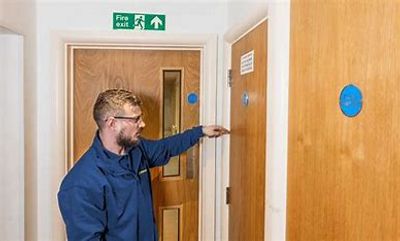Fire Door Surveys

Fire resisting doorsets are a vital passive fire protection measure and will be found in almost all buildings, providing protection to escape routes and areas of high fire risk for example. They are often subject to damage due to misuse or general wear and tear and should undergo regular inspection to ensure they continue to function properly. Fire door inspections allow for remedial work to be identified and subsequently implemented to ensure the spread of fire can be minimised and provide building occupants with additional time to escape. A fire door inspection scheme should include in-house visual inspections and, where necessary, full surveys by a competent contractor.
The objective of fire resisting doorsets is to assist in preventing the spread of smoke and flames in the event of a building fire. Fire resisting compartmentation is used alongside doorsets to subdivide the building. In most buildings, this fire protection is a legal obligation under both Building Regulations and to meet the requirements of the Regulatory Reform (Fire Safety) Order 2005 in England and Wales (and similar legislation in Scotland and Northern Ireland). It can protect escape routes, high-risk or high-value areas, and prevent extensive losses.
The Responsible Person should ensure that a suitable and sufficient fire risk assessment has been undertaken and this will typically involve a review of the condition of existing fire doorsets. However, the scope of a fire risk assessment will not extensively cover all fire doors and frames. Sampling can indicate the presence of significant issues, such as incorrectly fitting doors, missing features (such as intumescent seals, if required) and obvious signs of damage, but a more extensive door inspection survey may be required.
What is included?
A non-destructive and non-intrusive survey comprising:
- a comprehensive visual inspection of each fire resisting doorset including:
- the fire resisting qualities of the fire door hinges and all door hardware
- the condition, fitting, and operation of the hinges and hardware
- a review of fire door signage
- a check of the condition and operation of any hold open devices
- a check of the fire door closing devices and their ability to effectively close the doorsets
- a check for relevant markings, for example from the British Woodworking Federation to identify the fire rating of the doorset
- an inspection of the locks and latches to ensure they are operational
- an inspection of any vision panels, glazing, and review of their suitability
- an inspection of the cold smoke seals
- an inspection of the intumescent strips
- an assessment on the fire resisting qualities of the doorset, including its thickness
- a review of the gaps between the leaf and frame – including the threshold for suitability
- a visual inspection of the fire door frame
- a visual inspection of the door leaf
- a review of the materials used in the installation of the doorset
- a clear action plan which outlines the locations of defects, photographic evidence, and suggested remedial actions.